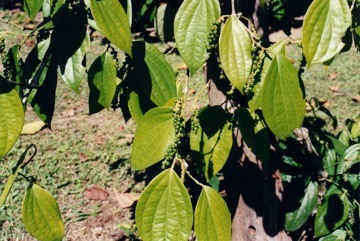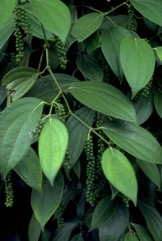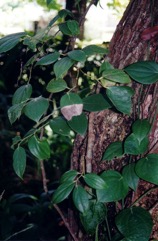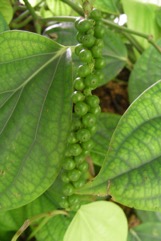Pepper

It is a tropical plant. It grows from sea level up to at least 1100 m altitude in equatorial places. It suits areas with a temperature between 24° and 26°C. It cannot tolerate frost. It likes high humidity and shade. It does best with a rainfall between 1200 and 2500 mm per year. It has been planted in commercial stands in a few coastal areas of Papua New Guinea. In the Cairns Botanical Gardens. It originally came from the tropics of India. It occurs in the Western Ghats in India. It suits hardiness zones 10-12.
Also known as:
Black pepper, Bumawng-ru, Gol morich, Hapusha, Jaluk, Kalamari, Kalamorich, Kalimirch, Kalomirich, Kapidi, Kare menasu, Konda miriyam, Kurumulaku, Lada hitam, Lada puteh, Lado ketek, Lado kobon, Maricha, Merica, Micha, Milagu, Mire, Miriyala tige, Morshaidi, Nallamulaku, Nga-yok-kaung, Paminta, Pappaa, Pedes, Pepe nero, Pfeffer, Phrik tai, Pimenta negra, Pimienta, Poivre, Priktai, Sayo-me, U-pinlong, Ushana, White pepper, Zwarte
Synonyms
- Muldera multinervis Miq.
Edible Portion
- Seeds, Herb, Spice, Fruit
Where does Pepper grow?
Found in: Africa, Asia, Australia, Bangladesh, Bougainville, Brazil, Burkina Faso, Cambodia, Cameroon, Central Africa, Central America, China, Congo DR, Cook Islands, Costa Rica, Cuba, East Africa, East Timor, Ethiopia, Fiji, FSM, Guam, Guatemala, Guyana, Hawaii, Himalayas, India, Indochina, Indonesia, Laos, Madagascar, Malaysia, Myanmar, Northeastern India, Pacific, Papua New Guinea, PNG, Peru, Philippines, Pohnpei, Sao Tome and Principe, SE Asia, Singapore, South America, Spain, Sri Lanka, Suriname, Thailand, Timor-Leste, United States, Vanuatu, Venezuela, Vietnam, Wallis and Futuna, West Africa, West Indies
Notes: There are between 1000-2000 Piper species. They are mostly in the tropics.
Status: In Papua New Guinea it is becoming of some importance as a cash crop but is little used locally as a spice. About 80,000 tons are produced each year worldwide. It is a cultivated food plant.
Growing Pepper
Cultivation: Plants are normally grown from cuttings of the main (rooted) vine. Pruning of the tips can increase branch formation on which berries are produced. It needs a support to climb. Plants can be grown from seeds.
Edible Uses: The berries are used as a spice. The dried fruit are used as pepper. Black pepper is dried with the skin on and white pepper has the skin soaked off and removed before drying. Immature green berries are sold in brine or dried.
Production: Berries dried with the skin give white pepper. Berries where the skin is soaked off produce black pepper. To do these they are soaked in water for a few days. Plants produce in the third year. They can continue producing for 20 years. Flowering normally follows rain. Fruit ripen after 3-4 months.
Nutrition Info
per 100g edible portion| Edible Part | Energy (kcal) | Protein (g) | Iron (mg) | Vitamin A (ug) | Vitamin c (mg) | Zinc (mg) | % Water |
|---|---|---|---|---|---|---|---|
| Seeds - black | 255 | 11 | 28.9 | 19 | 21 | 1.4 | 10.5 |
| Seeds - white | 296 | 10.4 | 14.3 | 0 | 21 | 1.1 | 11.4 |
Pepper Photos





References
Ambasta, S.P. (Ed.), 2000, The Useful Plants of India. CSIR India. p 460
Bodkin, F., 1991, Encyclopedia Botanica. Cornstalk publishing, p 804
Bremness, L., 1994, Herbs. Collins Eyewitness Handbooks. Harper Collins. p 283
Brickell, C. (Ed.), 1999, The Royal Horticultural Society A-Z Encyclopedia of Garden Plants. Convent Garden Books. p 804
Burkill, H. M., 1985, The useful plants of west tropical Africa, Vol. 4. Kew.
Burkill, I.H., 1966, A Dictionary of the Economic Products of the Malay Peninsula. Ministry of Agriculture and Cooperatives, Kuala Lumpur, Malaysia. Vol 2 (I-Z) p 1776
Chin, H. F., 1999, Malaysian Vegetables in Colour. Tropical Press. p 87
Cobley, L.S. (rev. Steele, W.M.) 2nd Ed., 1976, An Introduction to the Botany of Tropical Crops. Longmans. p 236
Cundall, P., (ed.), 2004, Gardening Australia: flora: the gardener's bible. ABC Books. p 1052
Facciola, S., 1998, Cornucopia 2: a Source Book of Edible Plants. Kampong Publications, p 172
Flowerdew, B., 2000, Complete Fruit Book. Kyle Cathie Ltd., London. p 163
French, B.R., 1986, Food Plants of Papua New Guinea, A Compendium. Asia Pacific Science Foundation p 375
French, B.R., 2010, Food Plants of Solomon Islands. A Compendium. Food Plants International Inc. p 367
Hedrick, U.P., 1919, (Ed.), Sturtevant's edible plants of the world. p 500
Hemphill, I, 2002, Spice Notes. Macmillan. p 299
Heywood, V.H., Brummitt, R.K., Culham, A., and Seberg, O., 2007, Flowering Plant Families of the World. Royal Botanical Gardens, Kew. p 256
http://www.botanic-gardens-ljubljana.com/en/plants
Hu, Shiu-ying, 2005, Food Plants of China. The Chinese University Press. p 333
Tseng Yung-chien, Xia Nianhe, Gilbert, M.G., Piperaceae. Flora of China.
Gouldstone, S., 1983, Growing your own Food-bearing Plants in Australia. Macmillan p 177
Hibbert, M., 2002, The Aussie Plant Finder 2002, Florilegium. p 235
Hutton, W., 1997, Tropical Herbs and Spices of Indonesia. Periplus. p 46
Kiple, K.F. & Ornelas, K.C., (eds), 2000, The Cambridge World History of Food. CUP p 433, 1832
Kybal, J., 1980, Herbs and Spices, A Hamlyn Colour Guide, Hamlyn Sydney p 156
Latham, P., 2004, Useful Plants of Bas-Congo province. Salvation Army & DFID p 224
Llamas, K.A., 2003, Tropical Flowering Plants. Timber Press. p 313
Macmillan, H.F. (Revised Barlow, H.S., et al), 1991, Tropical Planting and Gardening. Sixth edition. Malayan Nature Society. Kuala Lumpur. p 383
Medhi, P. & Borthakur, S. K., 2012, Phytoresources from North Cachur Hills of Assam -3: Edible plants sold at Hflong market. Indian Journal of Natural Products and Resources. 3(1) pp 84-109
Mertz, O., Lykke, A. M., and Reenberg, A., 2001, Importance and Seasonality of Vegetable Consumption and Marketing in Burkina Faso. Economic Botany, 55(2):276-289
Miguel, E., et al, 1989, A checklist of the cultivated plants of Cuba. Kulturpflanze 37. 1989, 211-357
Moerman, D. F., 2010, Native American Ethnobotany. Timber Press. p 415
Molla, A., Ethiopian Plant Names. http://www.ethiopic.com/aplants.htm
Morton,
Mulherin, J., 1994, Spices and natural flavourings. Tiger Books, London. p 75
Murtem, G. & Chaudhrey, P., 2016, An ethnobotanical note on wild edible plants of Upper Eastern Himalaya, India. Brazilian Journal of Biological Sciences, 2016, v. 3, no. 5, p. 63-81
Norrington, L., & Campbell, C., 2001, Tropical Food Gardens. Bloomings Books. p 71
Ochse,
Omawale, 1973, Guyana's edible plants. Guyana University, Georgetown p 63
Owen, S., 1993, Indonesian Food and Cookery, INDIRA reprints. p 74
Pham-Hoang Ho, 1999, An Illustrated Flora of Vietnam. Nha Xuat Ban Tre. p 292
Phon, P., 2000, Plants used in Cambodia. © Pauline Dy Phon, Phnom Penh, Cambodia. p 502
Purseglove, J.W., 1968, Tropical Crops Dicotyledons, Longmans. p 441
Rajapaksha, U., 1998, Traditional Food Plants in Sri Lanka. HARTI, Sri Lanka. p 380
Rao, M. L. S., et al, 2014, Indigenous Plant Foods which are commonly consumed by the tribal communities in Dumbriguda Area of Visakhapatnam District, Andhra Pradesh, India. Biolife. Vol 2, Issue 3
Rashid, H. E., 1977, Geography of Bangladesh. Westview. p 280
Sasi, R. & Rajendran, A., 2012, Diversity of Wild Fruits in Nilgiri Hills of the Southern Western Ghats - Ethnobotanical Aspects. IJABPT, 3(1) p 82-87
Small, E., 2009, Top 100 Food Plants. The world's most important culinary crops. NRC Research Press. p 420
Smith, A.C., 1981, Flora Vitiensis Nova, Lawaii, Kuai, Hawaii, Volume 2 p 59
Solomon, C., 2001, Encyclopedia of Asian Food. New Holland. p 278
Sp. pl. 1:28. 1753
Staples, G.W. and Herbst, D.R., 2005, A tropical Garden Flora. Bishop Museum Press, Honolulu, Hawaii. p 457
Sukarya, D. G., (Ed.) 2013, 3,500 Plant Species of the Botanic Gardens of Indonesia. LIPI p 955
Sukenti, K., et al, 2016, Ethnobotanical study on local cuisine of the Sasak tribe in Lombok Island, Indonesia. Journal of Ethnic Foods. 3 (2016) 189-200 p 198
Tyagi, R. K., et al, 2004, Conservation of Spices Germplasm in India. Indian J. Plant Genet. Resour. 17(3): 163-174
Vael, L., 2015, Ethnobotanical study of the plant use in the natural landscape of two mestizo communities in the Ucayali region of the Peruvian Amazon. Universiteit Gent.
van Wyk, B., 2005, Food Plants of the World. An illustrated guide. Timber press. p 298
Vickery, M.L. and Vickery, B., 1979, Plant Products of Tropical Africa, Macmillan. p 88
Vivien, J., & Faure, J.J., 1996, Fruitiers Sauvages d'Afrique. Especes du Cameroun. CTA p 262
Walter, A. & Lebot, V., 2007, Gardens of Oceania. ACIAR Monograph No. 122. CD-ROM minor species p 18
Williams, C.N., Chew, W.Y., and Rajaratnam, J.A., 1989, Tree and Field Crops of the Wetter Regions of the Tropics. Longman, p 218
Woodward, P., 2000, Asian Herbs and Vegetables. Hyland House. p
World Checklist of Useful Plant Species 2020. Royal Botanic Gardens, Kew
Zeven, A.C., 1979, Black Pepper, in Simmonds, N.W., (ed), Crop Plant Evolution. Longmans. London. p 234
Zuchowski W., 2007, Tropical Plants of Costa Rica. A Zona Tropical Publication, Comstock Publishing. p 191